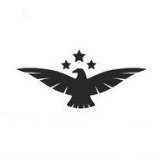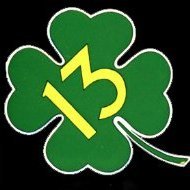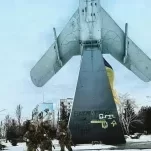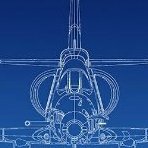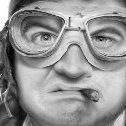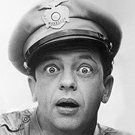-
Posts
349 -
Joined
-
Last visited
-
Days Won
1
Reputation Activity
-
 VintageEagle got a reaction from RBrown in Revell 1/32 Me 262 A-1a W.Nr. 110958 'White 17' III./EJG 2 - THE COCKPIT
VintageEagle got a reaction from RBrown in Revell 1/32 Me 262 A-1a W.Nr. 110958 'White 17' III./EJG 2 - THE COCKPIT
Hello,
After having worked for a loooong time on the Revell 1/32 Fw 190 A-8 I needed something else to get my mojo back. The Fw 190 A-8 is almost ready for paint, but when I went over the fuselage rivets again to prepare the surface for painting, the glue joints of the cockpit broke and the cockpit got detached. Fortunately not on all sides so that I can push it up again from the bottom, but that incident vaporized my motivation for a while. So hopefully a fresh start will bring the motivation back.
This time it is my favourite WW2 aircraft, the Me 262. I opted for 'White 17' W.Nr. 110958 of III./EJG 2 at Lechfeld for a number of reasons: 1) it is a very well documented bird, 2) there exists a color photo, 3) it had a very interesting camouflage with a nose section that came from a different aircraft (the nose tip appears to be from a 3rd aircraft).
The Revell kit has great details out of the box. I wanted to use the kit parts for the cockpit as I don't like Eduard's color printed P/E approach as it is too flat and it depicts a blind flying panel for a very late production variant that had a single-axis auto pilot and required a large repeater compass. Unfortunately, they don't offer resin parts anymore like they did for the Fw 190. The kit part is very good except that instrument layout is that of a early production model and has a cabin pressure gauge that was never installed in serial production aircraft (only in some prototypes or aircraft for testing):
Around the end of 1944, there was an effort to simplify the Me 262, the so-called 'Entfeinerung'. It is even mentioned in the cockpit overview of the pilot's manual, but I have also copies of wartime Messerschmitt documents that prove this. Very late production aircraft did not have the two differential pressure and oil pressure indicators anymore, just the fuel gauges and fuel pressure indicators and the two rpm indicator. W.Nr. 110958 was built around January 1945 and still had the differential pressure and oil pressure gauges. There exists immediate postwar footage of the cockpit of W.Nr. 110426 (captured by the Russians) and I own an original immediate postwar photo of the cockpit of W.Nr. 110836 that I use as reference for the required changes:
- Remove the cabin pressure gauge (left of the SZKK2 round counter box)
- Remove the indicators for the MK 108 underneath the SZKK2, the holes were sometimes left open or covered by a sheet of metall or fabric
- Remove the fuel warning indicators (again, the holes were sometimes left open or were covered)
- Remove the Junghans watch on the left side of the cabin pressure gauge as they were very rarely installed (in most cases the opening was left open)
- The casings of the ASI and rate of climb indicator on the backside are too short and needs to be replaced with longer casings
The second thing I wanted to correct was the relatively crude ZSK 244 bomb fusing auxiliary panel that was fitted to almost all the Me 262 As except for the recon versions and the ones (retro)fitted with R4M rockets. The ZSK 244 front plate is quite good, but the panel is flat and doesn't correspond to the original at all. The original had an angle of 15 degrees vs. vertical so that the pilot could better see and operate the instrument.
Here are two photos of the original part:
I constructed one from scratch using the dimensions of the original and photos as reference. The only part from the kit I used was the front plate of the ZSK 244. I had to carefully sand the kit part to the appropriate thickness.
It was a lot of work, but now I am happy with the way the instrument panel looks. Next is painting.
Roger
-
 VintageEagle got a reaction from IainM in Revell 1/32 Me 262 A-1a W.Nr. 110958 'White 17' III./EJG 2 - THE COCKPIT
VintageEagle got a reaction from IainM in Revell 1/32 Me 262 A-1a W.Nr. 110958 'White 17' III./EJG 2 - THE COCKPIT
Hello,
After having worked for a loooong time on the Revell 1/32 Fw 190 A-8 I needed something else to get my mojo back. The Fw 190 A-8 is almost ready for paint, but when I went over the fuselage rivets again to prepare the surface for painting, the glue joints of the cockpit broke and the cockpit got detached. Fortunately not on all sides so that I can push it up again from the bottom, but that incident vaporized my motivation for a while. So hopefully a fresh start will bring the motivation back.
This time it is my favourite WW2 aircraft, the Me 262. I opted for 'White 17' W.Nr. 110958 of III./EJG 2 at Lechfeld for a number of reasons: 1) it is a very well documented bird, 2) there exists a color photo, 3) it had a very interesting camouflage with a nose section that came from a different aircraft (the nose tip appears to be from a 3rd aircraft).
The Revell kit has great details out of the box. I wanted to use the kit parts for the cockpit as I don't like Eduard's color printed P/E approach as it is too flat and it depicts a blind flying panel for a very late production variant that had a single-axis auto pilot and required a large repeater compass. Unfortunately, they don't offer resin parts anymore like they did for the Fw 190. The kit part is very good except that instrument layout is that of a early production model and has a cabin pressure gauge that was never installed in serial production aircraft (only in some prototypes or aircraft for testing):
Around the end of 1944, there was an effort to simplify the Me 262, the so-called 'Entfeinerung'. It is even mentioned in the cockpit overview of the pilot's manual, but I have also copies of wartime Messerschmitt documents that prove this. Very late production aircraft did not have the two differential pressure and oil pressure indicators anymore, just the fuel gauges and fuel pressure indicators and the two rpm indicator. W.Nr. 110958 was built around January 1945 and still had the differential pressure and oil pressure gauges. There exists immediate postwar footage of the cockpit of W.Nr. 110426 (captured by the Russians) and I own an original immediate postwar photo of the cockpit of W.Nr. 110836 that I use as reference for the required changes:
- Remove the cabin pressure gauge (left of the SZKK2 round counter box)
- Remove the indicators for the MK 108 underneath the SZKK2, the holes were sometimes left open or covered by a sheet of metall or fabric
- Remove the fuel warning indicators (again, the holes were sometimes left open or were covered)
- Remove the Junghans watch on the left side of the cabin pressure gauge as they were very rarely installed (in most cases the opening was left open)
- The casings of the ASI and rate of climb indicator on the backside are too short and needs to be replaced with longer casings
The second thing I wanted to correct was the relatively crude ZSK 244 bomb fusing auxiliary panel that was fitted to almost all the Me 262 As except for the recon versions and the ones (retro)fitted with R4M rockets. The ZSK 244 front plate is quite good, but the panel is flat and doesn't correspond to the original at all. The original had an angle of 15 degrees vs. vertical so that the pilot could better see and operate the instrument.
Here are two photos of the original part:
I constructed one from scratch using the dimensions of the original and photos as reference. The only part from the kit I used was the front plate of the ZSK 244. I had to carefully sand the kit part to the appropriate thickness.
It was a lot of work, but now I am happy with the way the instrument panel looks. Next is painting.
Roger
-
 VintageEagle got a reaction from Supersonic in Revell 1/32 Me 262 A-1a W.Nr. 110958 'White 17' III./EJG 2 - THE COCKPIT
VintageEagle got a reaction from Supersonic in Revell 1/32 Me 262 A-1a W.Nr. 110958 'White 17' III./EJG 2 - THE COCKPIT
Hello,
After having worked for a loooong time on the Revell 1/32 Fw 190 A-8 I needed something else to get my mojo back. The Fw 190 A-8 is almost ready for paint, but when I went over the fuselage rivets again to prepare the surface for painting, the glue joints of the cockpit broke and the cockpit got detached. Fortunately not on all sides so that I can push it up again from the bottom, but that incident vaporized my motivation for a while. So hopefully a fresh start will bring the motivation back.
This time it is my favourite WW2 aircraft, the Me 262. I opted for 'White 17' W.Nr. 110958 of III./EJG 2 at Lechfeld for a number of reasons: 1) it is a very well documented bird, 2) there exists a color photo, 3) it had a very interesting camouflage with a nose section that came from a different aircraft (the nose tip appears to be from a 3rd aircraft).
The Revell kit has great details out of the box. I wanted to use the kit parts for the cockpit as I don't like Eduard's color printed P/E approach as it is too flat and it depicts a blind flying panel for a very late production variant that had a single-axis auto pilot and required a large repeater compass. Unfortunately, they don't offer resin parts anymore like they did for the Fw 190. The kit part is very good except that instrument layout is that of a early production model and has a cabin pressure gauge that was never installed in serial production aircraft (only in some prototypes or aircraft for testing):
Around the end of 1944, there was an effort to simplify the Me 262, the so-called 'Entfeinerung'. It is even mentioned in the cockpit overview of the pilot's manual, but I have also copies of wartime Messerschmitt documents that prove this. Very late production aircraft did not have the two differential pressure and oil pressure indicators anymore, just the fuel gauges and fuel pressure indicators and the two rpm indicator. W.Nr. 110958 was built around January 1945 and still had the differential pressure and oil pressure gauges. There exists immediate postwar footage of the cockpit of W.Nr. 110426 (captured by the Russians) and I own an original immediate postwar photo of the cockpit of W.Nr. 110836 that I use as reference for the required changes:
- Remove the cabin pressure gauge (left of the SZKK2 round counter box)
- Remove the indicators for the MK 108 underneath the SZKK2, the holes were sometimes left open or covered by a sheet of metall or fabric
- Remove the fuel warning indicators (again, the holes were sometimes left open or were covered)
- Remove the Junghans watch on the left side of the cabin pressure gauge as they were very rarely installed (in most cases the opening was left open)
- The casings of the ASI and rate of climb indicator on the backside are too short and needs to be replaced with longer casings
The second thing I wanted to correct was the relatively crude ZSK 244 bomb fusing auxiliary panel that was fitted to almost all the Me 262 As except for the recon versions and the ones (retro)fitted with R4M rockets. The ZSK 244 front plate is quite good, but the panel is flat and doesn't correspond to the original at all. The original had an angle of 15 degrees vs. vertical so that the pilot could better see and operate the instrument.
Here are two photos of the original part:
I constructed one from scratch using the dimensions of the original and photos as reference. The only part from the kit I used was the front plate of the ZSK 244. I had to carefully sand the kit part to the appropriate thickness.
It was a lot of work, but now I am happy with the way the instrument panel looks. Next is painting.
Roger
-
 VintageEagle got a reaction from Paul in Napier in Revell 1/32 Me 262 A-1a W.Nr. 110958 'White 17' III./EJG 2 - THE COCKPIT
VintageEagle got a reaction from Paul in Napier in Revell 1/32 Me 262 A-1a W.Nr. 110958 'White 17' III./EJG 2 - THE COCKPIT
Hello,
After having worked for a loooong time on the Revell 1/32 Fw 190 A-8 I needed something else to get my mojo back. The Fw 190 A-8 is almost ready for paint, but when I went over the fuselage rivets again to prepare the surface for painting, the glue joints of the cockpit broke and the cockpit got detached. Fortunately not on all sides so that I can push it up again from the bottom, but that incident vaporized my motivation for a while. So hopefully a fresh start will bring the motivation back.
This time it is my favourite WW2 aircraft, the Me 262. I opted for 'White 17' W.Nr. 110958 of III./EJG 2 at Lechfeld for a number of reasons: 1) it is a very well documented bird, 2) there exists a color photo, 3) it had a very interesting camouflage with a nose section that came from a different aircraft (the nose tip appears to be from a 3rd aircraft).
The Revell kit has great details out of the box. I wanted to use the kit parts for the cockpit as I don't like Eduard's color printed P/E approach as it is too flat and it depicts a blind flying panel for a very late production variant that had a single-axis auto pilot and required a large repeater compass. Unfortunately, they don't offer resin parts anymore like they did for the Fw 190. The kit part is very good except that instrument layout is that of a early production model and has a cabin pressure gauge that was never installed in serial production aircraft (only in some prototypes or aircraft for testing):
Around the end of 1944, there was an effort to simplify the Me 262, the so-called 'Entfeinerung'. It is even mentioned in the cockpit overview of the pilot's manual, but I have also copies of wartime Messerschmitt documents that prove this. Very late production aircraft did not have the two differential pressure and oil pressure indicators anymore, just the fuel gauges and fuel pressure indicators and the two rpm indicator. W.Nr. 110958 was built around January 1945 and still had the differential pressure and oil pressure gauges. There exists immediate postwar footage of the cockpit of W.Nr. 110426 (captured by the Russians) and I own an original immediate postwar photo of the cockpit of W.Nr. 110836 that I use as reference for the required changes:
- Remove the cabin pressure gauge (left of the SZKK2 round counter box)
- Remove the indicators for the MK 108 underneath the SZKK2, the holes were sometimes left open or covered by a sheet of metall or fabric
- Remove the fuel warning indicators (again, the holes were sometimes left open or were covered)
- Remove the Junghans watch on the left side of the cabin pressure gauge as they were very rarely installed (in most cases the opening was left open)
- The casings of the ASI and rate of climb indicator on the backside are too short and needs to be replaced with longer casings
The second thing I wanted to correct was the relatively crude ZSK 244 bomb fusing auxiliary panel that was fitted to almost all the Me 262 As except for the recon versions and the ones (retro)fitted with R4M rockets. The ZSK 244 front plate is quite good, but the panel is flat and doesn't correspond to the original at all. The original had an angle of 15 degrees vs. vertical so that the pilot could better see and operate the instrument.
Here are two photos of the original part:
I constructed one from scratch using the dimensions of the original and photos as reference. The only part from the kit I used was the front plate of the ZSK 244. I had to carefully sand the kit part to the appropriate thickness.
It was a lot of work, but now I am happy with the way the instrument panel looks. Next is painting.
Roger
-
 VintageEagle got a reaction from Greg W in Revell 1/32 Me 262 A-1a W.Nr. 110958 'White 17' III./EJG 2 - THE COCKPIT
VintageEagle got a reaction from Greg W in Revell 1/32 Me 262 A-1a W.Nr. 110958 'White 17' III./EJG 2 - THE COCKPIT
Hello,
After having worked for a loooong time on the Revell 1/32 Fw 190 A-8 I needed something else to get my mojo back. The Fw 190 A-8 is almost ready for paint, but when I went over the fuselage rivets again to prepare the surface for painting, the glue joints of the cockpit broke and the cockpit got detached. Fortunately not on all sides so that I can push it up again from the bottom, but that incident vaporized my motivation for a while. So hopefully a fresh start will bring the motivation back.
This time it is my favourite WW2 aircraft, the Me 262. I opted for 'White 17' W.Nr. 110958 of III./EJG 2 at Lechfeld for a number of reasons: 1) it is a very well documented bird, 2) there exists a color photo, 3) it had a very interesting camouflage with a nose section that came from a different aircraft (the nose tip appears to be from a 3rd aircraft).
The Revell kit has great details out of the box. I wanted to use the kit parts for the cockpit as I don't like Eduard's color printed P/E approach as it is too flat and it depicts a blind flying panel for a very late production variant that had a single-axis auto pilot and required a large repeater compass. Unfortunately, they don't offer resin parts anymore like they did for the Fw 190. The kit part is very good except that instrument layout is that of a early production model and has a cabin pressure gauge that was never installed in serial production aircraft (only in some prototypes or aircraft for testing):
Around the end of 1944, there was an effort to simplify the Me 262, the so-called 'Entfeinerung'. It is even mentioned in the cockpit overview of the pilot's manual, but I have also copies of wartime Messerschmitt documents that prove this. Very late production aircraft did not have the two differential pressure and oil pressure indicators anymore, just the fuel gauges and fuel pressure indicators and the two rpm indicator. W.Nr. 110958 was built around January 1945 and still had the differential pressure and oil pressure gauges. There exists immediate postwar footage of the cockpit of W.Nr. 110426 (captured by the Russians) and I own an original immediate postwar photo of the cockpit of W.Nr. 110836 that I use as reference for the required changes:
- Remove the cabin pressure gauge (left of the SZKK2 round counter box)
- Remove the indicators for the MK 108 underneath the SZKK2, the holes were sometimes left open or covered by a sheet of metall or fabric
- Remove the fuel warning indicators (again, the holes were sometimes left open or were covered)
- Remove the Junghans watch on the left side of the cabin pressure gauge as they were very rarely installed (in most cases the opening was left open)
- The casings of the ASI and rate of climb indicator on the backside are too short and needs to be replaced with longer casings
The second thing I wanted to correct was the relatively crude ZSK 244 bomb fusing auxiliary panel that was fitted to almost all the Me 262 As except for the recon versions and the ones (retro)fitted with R4M rockets. The ZSK 244 front plate is quite good, but the panel is flat and doesn't correspond to the original at all. The original had an angle of 15 degrees vs. vertical so that the pilot could better see and operate the instrument.
Here are two photos of the original part:
I constructed one from scratch using the dimensions of the original and photos as reference. The only part from the kit I used was the front plate of the ZSK 244. I had to carefully sand the kit part to the appropriate thickness.
It was a lot of work, but now I am happy with the way the instrument panel looks. Next is painting.
Roger
-
 VintageEagle got a reaction from John1 in Revell 1/32 Me 262 A-1a W.Nr. 110958 'White 17' III./EJG 2 - THE COCKPIT
VintageEagle got a reaction from John1 in Revell 1/32 Me 262 A-1a W.Nr. 110958 'White 17' III./EJG 2 - THE COCKPIT
Hello,
After having worked for a loooong time on the Revell 1/32 Fw 190 A-8 I needed something else to get my mojo back. The Fw 190 A-8 is almost ready for paint, but when I went over the fuselage rivets again to prepare the surface for painting, the glue joints of the cockpit broke and the cockpit got detached. Fortunately not on all sides so that I can push it up again from the bottom, but that incident vaporized my motivation for a while. So hopefully a fresh start will bring the motivation back.
This time it is my favourite WW2 aircraft, the Me 262. I opted for 'White 17' W.Nr. 110958 of III./EJG 2 at Lechfeld for a number of reasons: 1) it is a very well documented bird, 2) there exists a color photo, 3) it had a very interesting camouflage with a nose section that came from a different aircraft (the nose tip appears to be from a 3rd aircraft).
The Revell kit has great details out of the box. I wanted to use the kit parts for the cockpit as I don't like Eduard's color printed P/E approach as it is too flat and it depicts a blind flying panel for a very late production variant that had a single-axis auto pilot and required a large repeater compass. Unfortunately, they don't offer resin parts anymore like they did for the Fw 190. The kit part is very good except that instrument layout is that of a early production model and has a cabin pressure gauge that was never installed in serial production aircraft (only in some prototypes or aircraft for testing):
Around the end of 1944, there was an effort to simplify the Me 262, the so-called 'Entfeinerung'. It is even mentioned in the cockpit overview of the pilot's manual, but I have also copies of wartime Messerschmitt documents that prove this. Very late production aircraft did not have the two differential pressure and oil pressure indicators anymore, just the fuel gauges and fuel pressure indicators and the two rpm indicator. W.Nr. 110958 was built around January 1945 and still had the differential pressure and oil pressure gauges. There exists immediate postwar footage of the cockpit of W.Nr. 110426 (captured by the Russians) and I own an original immediate postwar photo of the cockpit of W.Nr. 110836 that I use as reference for the required changes:
- Remove the cabin pressure gauge (left of the SZKK2 round counter box)
- Remove the indicators for the MK 108 underneath the SZKK2, the holes were sometimes left open or covered by a sheet of metall or fabric
- Remove the fuel warning indicators (again, the holes were sometimes left open or were covered)
- Remove the Junghans watch on the left side of the cabin pressure gauge as they were very rarely installed (in most cases the opening was left open)
- The casings of the ASI and rate of climb indicator on the backside are too short and needs to be replaced with longer casings
The second thing I wanted to correct was the relatively crude ZSK 244 bomb fusing auxiliary panel that was fitted to almost all the Me 262 As except for the recon versions and the ones (retro)fitted with R4M rockets. The ZSK 244 front plate is quite good, but the panel is flat and doesn't correspond to the original at all. The original had an angle of 15 degrees vs. vertical so that the pilot could better see and operate the instrument.
Here are two photos of the original part:
I constructed one from scratch using the dimensions of the original and photos as reference. The only part from the kit I used was the front plate of the ZSK 244. I had to carefully sand the kit part to the appropriate thickness.
It was a lot of work, but now I am happy with the way the instrument panel looks. Next is painting.
Roger
-
 VintageEagle got a reaction from Sasha As in Revell 1/32 Me 262 A-1a W.Nr. 110958 'White 17' III./EJG 2 - THE COCKPIT
VintageEagle got a reaction from Sasha As in Revell 1/32 Me 262 A-1a W.Nr. 110958 'White 17' III./EJG 2 - THE COCKPIT
Hello,
After having worked for a loooong time on the Revell 1/32 Fw 190 A-8 I needed something else to get my mojo back. The Fw 190 A-8 is almost ready for paint, but when I went over the fuselage rivets again to prepare the surface for painting, the glue joints of the cockpit broke and the cockpit got detached. Fortunately not on all sides so that I can push it up again from the bottom, but that incident vaporized my motivation for a while. So hopefully a fresh start will bring the motivation back.
This time it is my favourite WW2 aircraft, the Me 262. I opted for 'White 17' W.Nr. 110958 of III./EJG 2 at Lechfeld for a number of reasons: 1) it is a very well documented bird, 2) there exists a color photo, 3) it had a very interesting camouflage with a nose section that came from a different aircraft (the nose tip appears to be from a 3rd aircraft).
The Revell kit has great details out of the box. I wanted to use the kit parts for the cockpit as I don't like Eduard's color printed P/E approach as it is too flat and it depicts a blind flying panel for a very late production variant that had a single-axis auto pilot and required a large repeater compass. Unfortunately, they don't offer resin parts anymore like they did for the Fw 190. The kit part is very good except that instrument layout is that of a early production model and has a cabin pressure gauge that was never installed in serial production aircraft (only in some prototypes or aircraft for testing):
Around the end of 1944, there was an effort to simplify the Me 262, the so-called 'Entfeinerung'. It is even mentioned in the cockpit overview of the pilot's manual, but I have also copies of wartime Messerschmitt documents that prove this. Very late production aircraft did not have the two differential pressure and oil pressure indicators anymore, just the fuel gauges and fuel pressure indicators and the two rpm indicator. W.Nr. 110958 was built around January 1945 and still had the differential pressure and oil pressure gauges. There exists immediate postwar footage of the cockpit of W.Nr. 110426 (captured by the Russians) and I own an original immediate postwar photo of the cockpit of W.Nr. 110836 that I use as reference for the required changes:
- Remove the cabin pressure gauge (left of the SZKK2 round counter box)
- Remove the indicators for the MK 108 underneath the SZKK2, the holes were sometimes left open or covered by a sheet of metall or fabric
- Remove the fuel warning indicators (again, the holes were sometimes left open or were covered)
- Remove the Junghans watch on the left side of the cabin pressure gauge as they were very rarely installed (in most cases the opening was left open)
- The casings of the ASI and rate of climb indicator on the backside are too short and needs to be replaced with longer casings
The second thing I wanted to correct was the relatively crude ZSK 244 bomb fusing auxiliary panel that was fitted to almost all the Me 262 As except for the recon versions and the ones (retro)fitted with R4M rockets. The ZSK 244 front plate is quite good, but the panel is flat and doesn't correspond to the original at all. The original had an angle of 15 degrees vs. vertical so that the pilot could better see and operate the instrument.
Here are two photos of the original part:
I constructed one from scratch using the dimensions of the original and photos as reference. The only part from the kit I used was the front plate of the ZSK 244. I had to carefully sand the kit part to the appropriate thickness.
It was a lot of work, but now I am happy with the way the instrument panel looks. Next is painting.
Roger
-
 VintageEagle reacted to Thunnus in 1/32 Special Hobby Hawker Tempest V - Fairbanks JJ+F
VintageEagle reacted to Thunnus in 1/32 Special Hobby Hawker Tempest V - Fairbanks JJ+F
Thank you! Since I've learned so much and use other modelers' build logs as references for my own builds, it's nice to know that I'm returning the favor to the LSP community.
Thanks Andy! We are a compulsive and fastidious lot, aren't we?
Mr Color US Navy White C-316. It mixed with no issues with Mr Color Medium Sea Grey C-363 but didn't want to stay mixed with Mr Color Ocean Grey C-362.
Yeah, it felt good, Bill.
Me too but once I mentioned it, I was pretty much committed to doing something about it.
After the paint fix, I decided to do a little bit of the post-shading now, concentrating on the bottom. I use very dilute blackish brown mixes that are sprayed along panel lines and random streaks.
The model was sealed with a gloss coat (Alclad Aqua Gloss) to prepare for the next step, which is decaling. Actually, they are wet transfers from HGW but very similar to decals.
After cutting out the appropriate marking from the sheet, it is applied just like a decal: dip it in warm water to loosen the backing paper and slide it into place. A drop of Mark Setter goes onto the model before the decal and will act as an adhesive. No decal softener is needed... just blot out the bubbles and dry any excess moisture.
Allow this to dry for a few hours. Instructions say 6-8 hours but I've gotten good results after only a couple of hours. You can see the shiny carrier film in the above pic right? This is what differentiates a wet transfer from a decal. That carrier film is carefully removed, leaving ONLY the marking with absolutely zero decal film.
The Tempest doesn't have too many stencils so doing the bottom didn't take very long. The transfers are numbered in the same way as the kit instructions. This is handy because the drawings in the kit instructions are in color, making the identification of the smaller markings much easier.
I tested the wet transfers on the flaps, which have a flat finish, and they worked fine.
I mixed up a small batch of grey wash using pastel chalk and water to test (a) the color of the wash and (b) if the wash could be applied to the wet transfers without any ill effects.
Seemed to be ok on both counts so I applied the grey wash to the entire bottom.
Taking a pause here to touch-up some panel lines and rivets before I continue on the top side.
-
 VintageEagle got a reaction from Woody V in FW190 wing question
VintageEagle got a reaction from Woody V in FW190 wing question
Yes, that’s a flap indicator. In the Squadron Walkaround booklet there is an illustration of how it works if I remember correctly.
-
 VintageEagle got a reaction from Martinnfb in FW190 wing question
VintageEagle got a reaction from Martinnfb in FW190 wing question
Yes, that’s a flap indicator. In the Squadron Walkaround booklet there is an illustration of how it works if I remember correctly.
-
 VintageEagle reacted to Thunnus in Hasegawa 1/32 Fw 190D-9 Late "Brown 4"
VintageEagle reacted to Thunnus in Hasegawa 1/32 Fw 190D-9 Late "Brown 4"
Thanks guys!
I've gone through a few iterations of heavy sanding on the fuselage sides, each time cleaning the sanding dust off at the kitchen sink, taping the fuselage together and dry-fitting the cockpit tub into place. The cockpit tub itself is being temporarily held together using masking tape. Have you guys ever noticed that the yellow Tamiya tape doesn't stick well to resin?
The inside of the instrument panel hood is nicely detailed but you won't get to see much of it once it is installed.
I'm very close to having the fuselage sides thin enough to accommodate the resin cockpit tub without having to forced the fuselage sides closed. Taking into account the thickness of the masking tape, I'm probably just about there.
Checking to see if the instrument panel hood fits ok. Forget my previous work on the armor decking behind the seat. For some reason, I forgot that it does NOT seat on the original rails on the fuselage but within the resin rails, which are spaced narrower. After using this resin set twice before, that I would remember this. I pulled the armor decking from a second cockpit set and used the kit hatch on it. I'll have to salvage the erroneously modified deck later.
With the windscreen and canopy in place.
I am toying with the idea of posing the canopy open on this build.
-
 VintageEagle reacted to Artful69 in F/A-18C seamless intakes: options & comparison?
VintageEagle reacted to Artful69 in F/A-18C seamless intakes: options & comparison?
I have GT intakes for my Legacy Hornets and the Trumpeter issue Super ones (only because all the jet heads on here swear by the seamless thing for whatever reason) … I don’t particularly see any issue with them - moulding looks crisp - no flash etc … Before I bought them I didn’t see any bad reviews online so
Rog
-
 VintageEagle reacted to BloorwestSiR in F/A-18C seamless intakes: options & comparison?
VintageEagle reacted to BloorwestSiR in F/A-18C seamless intakes: options & comparison?
Here's the Rhino intakes I used on my Tiger Meet CF-18.
I installed them first before I put either side on
This seemed to give me the cleanest fit when I did it.
Carl
-
 VintageEagle got a reaction from Rick Griewski in Zoukei Mura - Old Man Blog No.115
VintageEagle got a reaction from Rick Griewski in Zoukei Mura - Old Man Blog No.115
If the pictured sprues are all included it should at least be the canopy and tall tail. The standard canopy can be seen in the latest post (part 5) and the different rudders in part 3. I also see both tall and short tail wheels in part 3. That gives plenty of options.
-
 VintageEagle got a reaction from adameliclem in Zoukei Mura - Old Man Blog No.115
VintageEagle got a reaction from adameliclem in Zoukei Mura - Old Man Blog No.115
The latest Old Man blog mentions which versions will follow after the first release. Unfortunately no DB 605AS or D versions:
‘‘G-2’’ ‘‘G-4’’ ‘‘G-6 Early Type’’ ‘‘G-6 Late Type’’ ‘‘G-14’’ and ‘‘G-6/U4’’
-
 VintageEagle got a reaction from Stefano in Zoukei Mura - Old Man Blog No.115
VintageEagle got a reaction from Stefano in Zoukei Mura - Old Man Blog No.115
The latest Old Man blog mentions which versions will follow after the first release. Unfortunately no DB 605AS or D versions:
‘‘G-2’’ ‘‘G-4’’ ‘‘G-6 Early Type’’ ‘‘G-6 Late Type’’ ‘‘G-14’’ and ‘‘G-6/U4’’
-
 VintageEagle reacted to Neo in F/A-18C seamless intakes: options & comparison?
VintageEagle reacted to Neo in F/A-18C seamless intakes: options & comparison?
So here is the result I got, bear in mind its my first time using seamless intakes in 1/32 (did a 1/48 A-7 years ago) and only my second Jet in 1/32 first being a T1 hawk so a more skilled modeler probably could have gotten these to fit well
I based the position of the intakes on the fit from the back of the intake to the fuselage, and glued them in before the wings and the side panel. having the winf in place i would have noticed the it needed to come up more to be snug with the wing.
-
 VintageEagle reacted to Starfighter in F/A-18C seamless intakes: options & comparison?
VintageEagle reacted to Starfighter in F/A-18C seamless intakes: options & comparison?
You are welcome. The Rhino ones are one-part intakes. No idea about the GT ones; having seen some of their other parts, I am not going to spend any money on their intakes.
-
 VintageEagle reacted to Radub in Zoukei Mura - Old Man Blog No.115
VintageEagle reacted to Radub in Zoukei Mura - Old Man Blog No.115
The bombs will not be included in the Hartmann kit. The "tall tail is included on the runner with the G-14 parts. It will be possible to make a G-14 with the "tall tail" from what it is in the box.
Radu
-
 VintageEagle reacted to Starfighter in F/A-18C seamless intakes: options & comparison?
VintageEagle reacted to Starfighter in F/A-18C seamless intakes: options & comparison?
I don't have any for sale but I have some information - the DMold ones are restocked from time to time and the concept seems to ease painting, but the parts dont fit that well, causing a step between the front part and the intake trunks. The Rhino ones are one-part intakes which makes painting more difficult; the problem with them is the fact that the mesh pattern is not properly molded. I will probably use Eduard PE meshes on the Rhino intakes.
-
 VintageEagle reacted to Thunnus in 1/32 Special Hobby Hawker Tempest V - Fairbanks JJ+F
VintageEagle reacted to Thunnus in 1/32 Special Hobby Hawker Tempest V - Fairbanks JJ+F
Thanks Chuck! Yes, the engine is really well cast and was the primary reason that I bought this kit. As for the nose fit, I can't really say for sure since I didn't really get a chance to fit the complete nose onto the fuselage and wings. But I think that the lack of rigidity caused by cutting off the top half of the nose contributed to the fit issues. Hopefully, it becomes a non-issue after the painting the stage.
Thanks Michael! It's always gratifying to get any fit issues dealt with and in the rear view mirror.
I am now slowly approaching the painting stage. I've masked the cockpit and engine off and now I have to do the same for the radiator outlet and the wheel wells.
-
 VintageEagle reacted to Dave Williams in F/A-18C seamless intakes: options & comparison?
VintageEagle reacted to Dave Williams in F/A-18C seamless intakes: options & comparison?
Unless Seamless Suckers has improved over stuff I’ve gotten many years ago, I’d pass on them. D-Mold is fine. In addition, Cutting Edge and Rhino also did intakes for the Academy Hornet and are comparable to the D-Mold ones (some say they are all the same, but don’t want to get into another who-copied-who discussion). The GT resin set is in stock at Sprue Brothers, but I don’t know if any of the others are available outside of eBay.
https://spruebrothers.com/gtr32052-1-32-gt-resin-f-18a-f-18b-f-18c-f-18d-hornet-seamless-intake-aca-kit/
-
 VintageEagle reacted to LSP_K2 in F/A-18C seamless intakes: options & comparison?
VintageEagle reacted to LSP_K2 in F/A-18C seamless intakes: options & comparison?
GT Resin, D-Mold and Seamless Suckers are all that I'm aware of. Which is better, I have no clue.
-
 VintageEagle reacted to thierry laurent in F/A-18C seamless intakes: options & comparison?
VintageEagle reacted to thierry laurent in F/A-18C seamless intakes: options & comparison?
Out of my memory the external dimensions are ok but the internal ones are too small because the front lips are too thick.
-
 VintageEagle got a reaction from Rick Griewski in Zoukei Mura - Old Man Blog No.115
VintageEagle got a reaction from Rick Griewski in Zoukei Mura - Old Man Blog No.115
https://www.zoukeimura.co.jp/sentiment/oyajiblog_120.html


